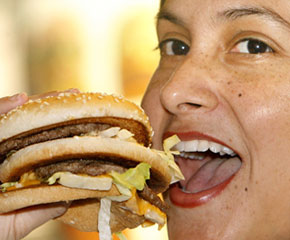Displaying restaurant offerings including a cheese-laden chicken-and-pasta dish they dubbed “Angioplasta,” officials at the Center for Science in the Public Interest said such dishes help fuel national epidemics of obesity and heart disease.
They urged local, state and national governments to make restaurants list nutritional data on their menus. Michael Jacobson, the group’s executive director, took aim at “table-service” chain restaurants like Ruby Tuesday’s and Uno Chicago Grill. Such places increasingly stuff their dishes with extra unhealthy ingredients, he said.
“What we’re finding is that table-service restaurants have launched into a whole new era of extreme eating,” Jacobson said. “If we’re going to deal with the epidemic of obesity and the tremendous prevalence of heart attacks and strokes, we’re going to have to do something about restaurant foods.”
Jacobson’s group often criticises at a variety of restaurant foods. Some critics deride the group as self-appointed food police.
Jacobson showed reporters an appetizer offered by Uno Chicago Grill that he said contained 2 050 calories. It was a cross between a pizza and stuffed potato skins, with a deep-dish pizza crust crammed with mozzarella and cheddar cheese, mashed potatoes, bacon and sour cream.
Ruby Tuesday’s offers an entree called Fresh Chicken & Broccoli Pasta so loaded with cheese and other stuff that it tipped the scales at 2 060 calories and 128 grams of fat, he said. Jacobson dubbed it “Angioplasta,” alluding to angioplasty, a medical procedure to open clogged arteries.
One slice of The Cheesecake Factory’s Chris’s Outrageous Chocolate Cake had 1 380 calories, with layers of cake, brownies, coconut pecan filling and chocolate-chip coconut cheesecake, the group said.
The average daily calorie requirement is about 2 000 for women and 2 500 for men.
The trade group National Restaurant Association said many restaurants provide nutritional information about their menus, and nearly all have healthy dishes available.
“Pointing to a select few menu items at a select few restaurants as being high in calories, and generalizing that to all restaurant fare is misleading, inaccurate and does the public a grave disservice,” the association said in a statement.
Jacobson said restaurants have had more than enough time to voluntarily provide nutritional data such as calorie, fat and salt content but many do not — and those that do often make the data hard to find.
“Restaurants have every right to make these foods and you have every right to eat them,” Jacobson said. “But I think at the very least these restaurants should give consumers the information that would enable them to make some decent eating choices.”

